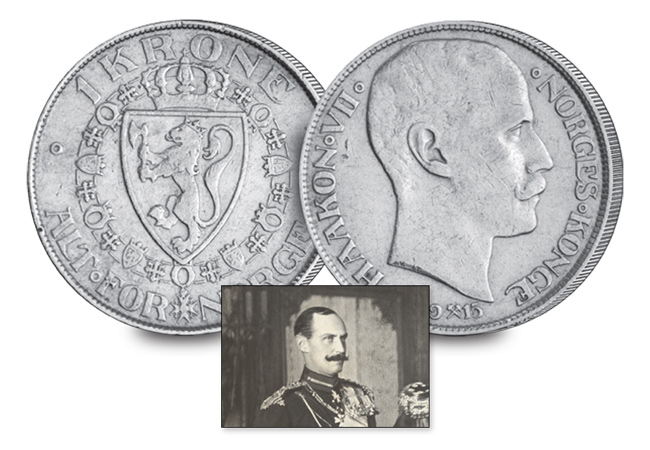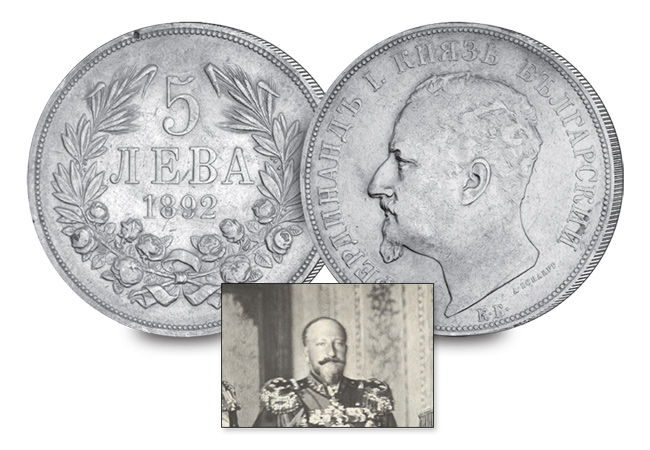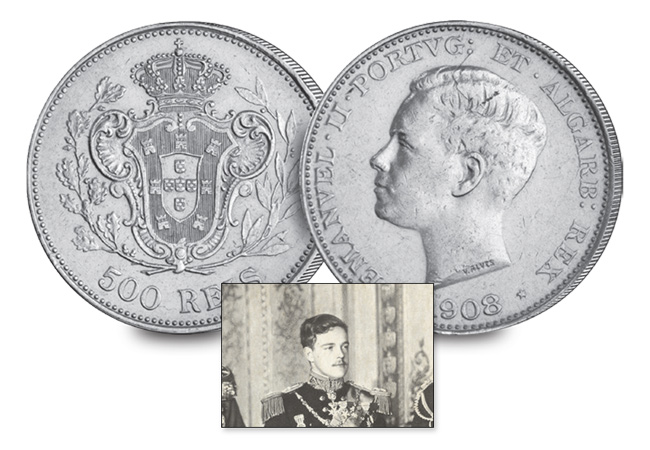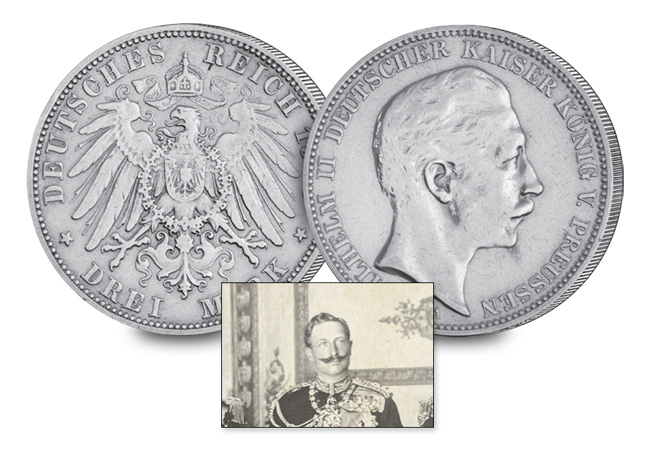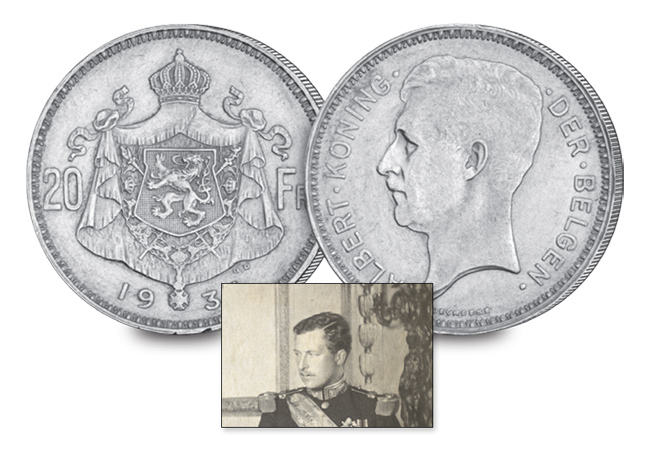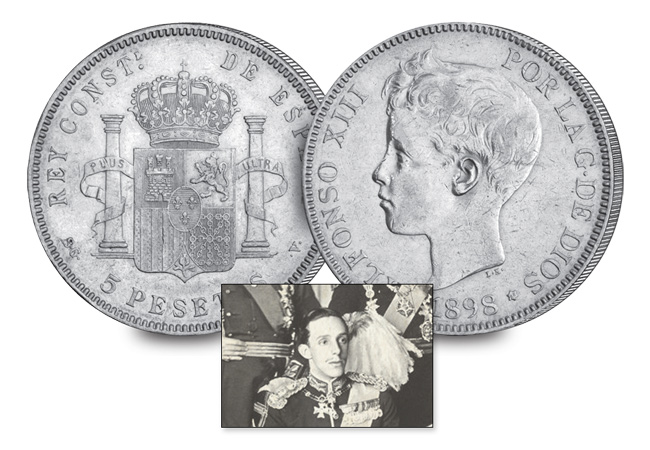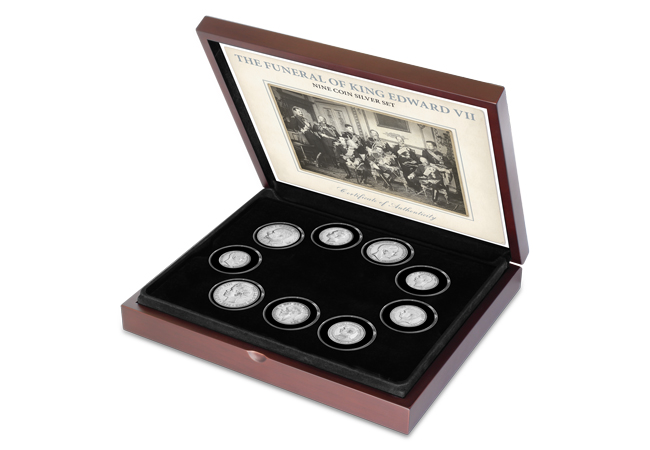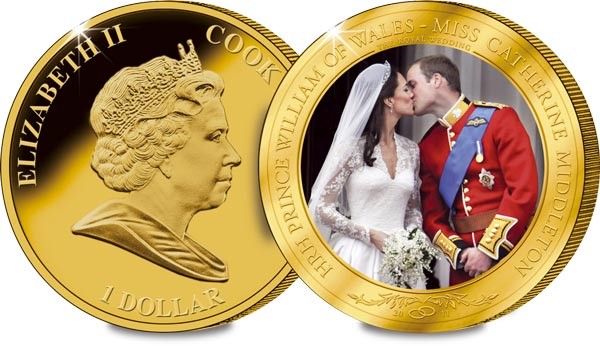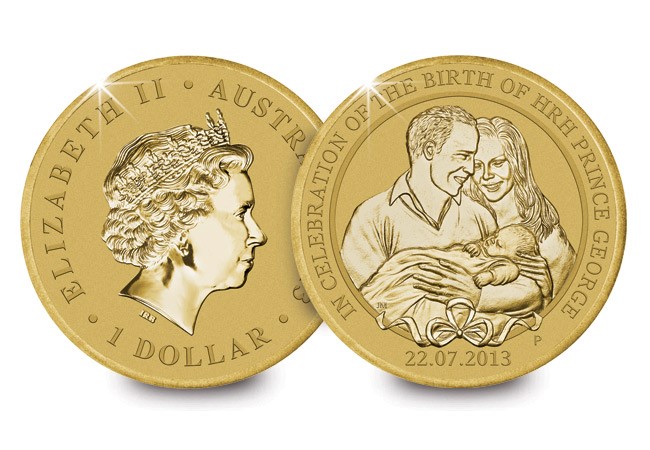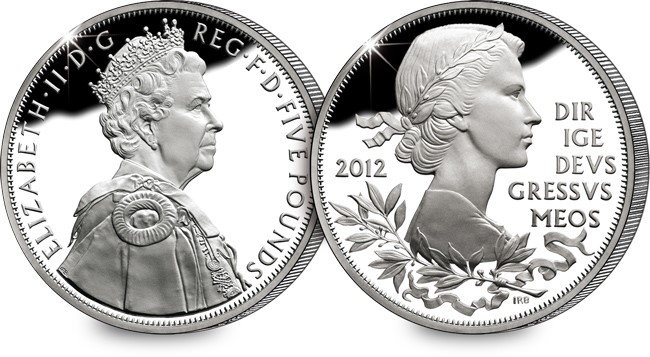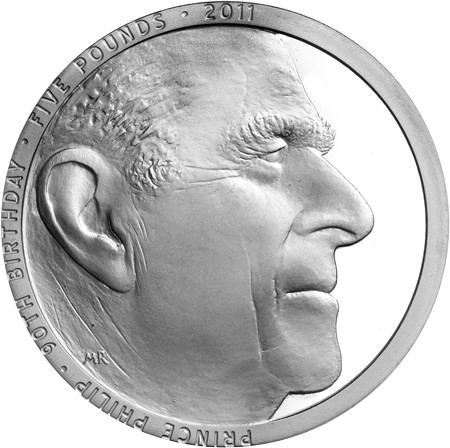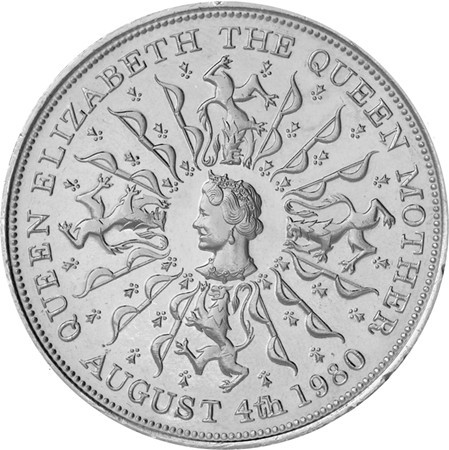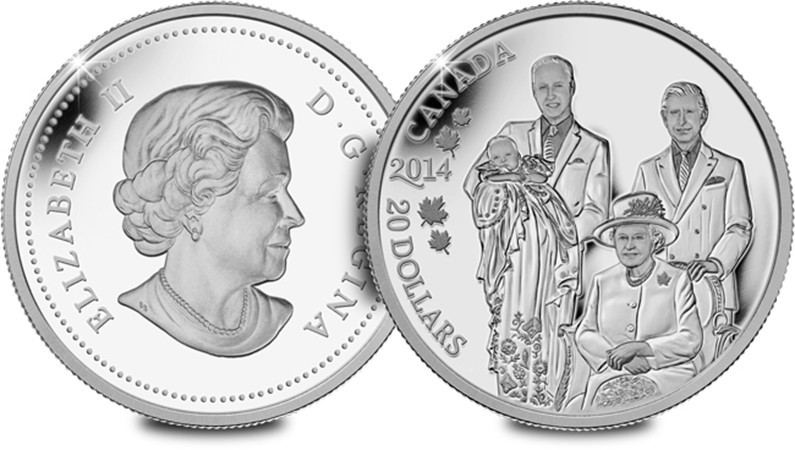Posts by charlottewestminster
Nine Kings in one room, nine great European currencies…
In 1910, one of the largest gatherings of European royalty took place for the funeral of King Edward VII – the ‘Uncle’ of Europe.
The nine Heads of State who were famously photographed in Windsor Castle also represented nine of the most important European currencies during that period in history. Now for the first time in the UK, the gathering has been recreated in a unique set of original coins from that era…
Standing: 1st from left – King Haakon VII of Norway
King Haakon VII ruled from 1905 until 1957, and he is regarded as one of the most important Norwegians of the 20th Century for his stoicism during WWII.
The 1 Kroner coin shown here was struck from 800/1000 Silver up until 1915. After this, Norway’s regular coinage was almost all cupro-nickel, marking the end of an era.
Standing: 2nd from left – Tsar Ferdinand of the Bulgarians
Tsar Ferdinand established the Royal dynasty in independent Bulgaria, in 1908 he was pronounced their first ever ‘King.’ But he was forced to abdicate during WWI, and he lived to see his monarchy deposed by Socialists in 1946.
However one thing did survive, and that was the Lev – the Bulgarian currency which is still in use today.
Standing: 3rd from left – King Manuel II of Portugal
King Manuel II was the last ever King of Portugal, as their monarchy was dissolved in October 1910 and Manuel spent the rest of his life in exile.
This makes Manuel II coins particularly sought after by collectors as they were only struck in three years – like the 500 Reis shown here.
Standing: 4th from left – Kaiser Wilhelm II of Germany and Prussia
In 1910, when this photograph was taken, Kaiser Wilhelm II was still held in some regard in Britain. The last ever Emperor of Germany and Prussia, he abdicated in 1918 after losing support from the military, marking the end of the German monarchy.
He left behind him a legacy of attractive 900/1000 silver Marks however, like the 2 Mark coin pictured here.
Standing: 5th from left – King George I of Hellenes
Originally a Danish prince, George was born in Copenhagen. He was only 17 years old when he was elected king and he reigned for almost 50 years – the longest in Modern Greek history. Unfortunately, King George’s reign came to an end on 18th March, 1913 when he was assassinated during the First Balkan War.
The distinctive 2 Drachmai which carries the King’s portrait features the Greek goddess Thetis with shield of Achilles, seated upon a seahorse.
Standing: 6th from left – King Albert I of Belgium
King Albert I reigned Belgium from 1909-1934, which was an eventful period in the History of Belgium. It included the period of World War I, the adoption of the Treaty of Versailles and the first five years of the Great Depression.
The 20 Franc coin pictured here was minted within the last two years of King Albert I’s reign and is incredibly collectible today. If your 1934 coin is struck en medaille then it is significantly rarer than the standard issues – definitely one to keep in the collection.
Sitting: 1st from left – King Alfonso XIII of Spain
Alfonso was monarch from birth as his father Alfonso XII had died the previous year. Until his 16th birthday in 1902, his mother, Maria Christina of Austria, served as his regent.
As he was born King, early coins from Alfonso’s reign featured his portrait as a child, such as this 5 Pesetas from 1898 which pictures the King at just 12 years old.
Sitting: 2nd from left – King George V of the United Kingdom
Upon the death of King Edward VIII, King George V became the new King of the United Kingdom, inheriting the throne at a politically turbulent time. He wrote in his diary:
“I have lost my best friend and the best of fathers … I never had a [cross] word with him in my life. I am heart-broken and overwhelmed with grief but God will help me in my responsibilities and darling May will be my comfort as she has always been. May God give me strength and guidance in the heavy task which has fallen on me”
His portrait was struck upon the half-crown, a British denomination equivalent to two shillings and sixpence, or one-eighth of a pound.
Sitting: 3rd from left – King Frederick VIII of Denmark
Frederick ascended the throne late in life, and only ruled for 6 years.
To mark both the death of his father King Christian IX in 1906 and Frederick’s accession to the throne, a 2 Kroner coin was issued that features both Christian IX and Frederick VIII – an extremely unusual and collectable ‘double obverse’ design.
I’ve only just scratched the surface of the coinage behind the remarkable photograph. Suffice to say, we will probably never see an assembly of Monarchs like it ever again.
You can own all of these fascinating coins in the limited edition Funeral of King Edward VII Nine Coin Silver Set.
Which Royal coins should I own? A collector’s guide.
Births, deaths, weddings, christenings, jubilees, anniversaries and birthdays – The Royal Family have had commemorative coins issued to mark them all.
But which Royal coins are really worth adding to your collection? With so many out there it can be difficult to know where to start. That’s why I’ve put together this guide to nine of my favourite coins, each representing a member of the modern Royal family. Without further ado, in no particular order…
1. Princess Diana
No royal collection would be complete without a Princess Diana coin.
The most poignant issue was struck by The Royal Mint in 1999 following the tragic death of ‘the people’s princess’. Diana touched the hearts and lives of thousands across the globe and this coin commemorates her life – with a beautifully engraved portrait by David Cornell. Such an important member of the Royal family should forever be remembered and this is the perfect way in which to pay tribute to her life.
2. Prince Charles
The Prince Charles 50th Birthday coin holds the distinction of being the rarest UK Gold £5 coin to be issued. Just 773 were struck and it also features the most words of any British coin within its design.
Prince Charles founded the Princes Trust in 1976 – a charity which was created in order to help the lives of disadvantaged young people. The coin was issued to celebrate his 50th birthday and honour his charity. As the longest serving heir in British history, Prince Charles is certainly a Royal figure that is certainly deserving of a commemorative coin.
3. The Duke and Duchess of Cambridge
The Royal Wedding of the Duke and Duchess of Cambridge was viewed by an estimated 2 billion people around the world.
The most iconic photograph of the whole ceremony was undoubtedly The Balcony Kiss – and this was captured perfectly on this Cook Islands $1 coin. Plated in 24 carat gold the Royal Wedding Photographic coin had an edition limit of just 24,500 – which isn’t many considering the number of people who tuned in to watch the ceremony. In years to come when William is King, those who have this coin will own a lasting memory of the day he married his Queen.
4. Prince George
Born 22nd July, 2013, the arrival of the young Prince George stirred global interest – especially from the USA. As the first son of the Duke and Duchess of Cambridge, Prince George became third in line to the throne and is our future King.
The Perth Mint issued a Royal commemorative coin which really stood out. Depicting William and Kate with the new-born Prince this was the first official coin from a major nation to feature an engraving of Prince George.
5. Princess Charlotte
On 2nd May this year, the Duke and Duchess of Cambridge welcomed their second child into the world – Princess Charlotte Elizabeth Diana. The Royal christening took place on 5th July at St Mary Magdalene church on the Sandringham estate.
With a design inspired by the stunning Lily Font which is used for Royal christenings, the Silver Proof £5 Coin issued by Guernsey captured the moment perfectly. The elaborate one-off design makes this one of the premier commemoratives celebrating the young Princess.
6. Queen Elizabeth II
In 2012 Her Majesty Queen Elizabeth II celebrated her Diamond Jubilee. It was a multinational celebration that marked the 60th anniversary of the her accession in 1952.
To celebrate, an exceptional ‘double obverse’ coin was issued. The coin is the first ever UK crown to feature the Queen’s full profile on both sides. With such a rare design, the Diamond Jubilee coin is certainly one which adds another dimension to any Royal collection.
7. Prince Philip
Prince Philip’s life of Royal service began at Queen Elizabeth II’s accession in 1952 when he was promoted to Commander after a distinguished career in the Royal Navy.
To mark his 90th birthday in 2011, a specially commissioned portrait was struck on a £5 coin issued by the Royal Mint. This was the first coin in British history to feature both a Monarch and a Consort on opposite sides.
8. Queen Elizabeth the Queen Mother
The 1980 UK 25p Coin was issued in celebration of the Queen Mother’s 80th birthday. The design features the effigy of the Queen Mother surrounded by bows and lions – which is a pun on her family name ‘Bowes-Lyon’
This was the penultimate 25p crown issued in the UK and was the first ever British coin to feature a living person other than the reigning monarch.
Special mention…
A special mention goes to the Canada 2014 $20 ‘Royal Generations’ Silver Proof Coin. This coin was issued to commemorate the birth of Prince George and pictures three generations of heirs.
I think it’s particularly special as Prince George’s birth marks only the second time in history that Britain has had three living male heirs to the throne from separate generations – and this coin captures them all.
So if you’re looking to put together a Royal collection, these coins are my personal recommendations, each with a story to tell. If you own some already, let me know in the comments…
The medal 30 years in the making…
With the Battle of Waterloo reaching its 200th Anniversary this year, I have come across some fascinating commemoratives which have been issued to mark the historic event. However, there was one in particular that really caught my eye and has an intriguing story behind it…
It all started in 1815 when The Royal Mint was commissioned by the Duke of Wellington to strike a medal honouring the leaders of the allied nations following the Battle of Waterloo.
The medal was to be of the grandest scale, finished with outstanding detail – a task perfectly suited to Royal Mint Chief Medalist Bendetto Pistrucci – whose proposed design was chosen from a shortlist.
Pistrucci was a masterful engraver with a mercurial personality. He had already completed a stunning design of St George and the Dragon (which famously still graces the Sovereign today). His design for the medal looked set to be one of the greatest ever undertaken…
But, there was a problem
Pistrucci was under the impression that Master of the Mint, William Wellsley-Pole, had promised him the position of Chief Engraver at the Royal Mint. However, as a result of politics and infighting at the Mint, it became apparent his ambitions would never be fulfilled.
In fact he soon recognised that once he had completed the Waterloo medal, The Royal Mint was sure to cut all ties with him. Determined not to let this happen, Pistrucci took his time, and prolonged the project – by 30 years.
By the time the dies were completed, all the intended recipients were dead, except for Wellington himself.
The end result was one of the most magnificent pieces of medallic art ever seen, but this wasn’t the end of the story. Pistrucci’s dies were so large and complicated that they proved impossible to harden and the medal that had taken three decades to complete was never even struck.
So the ill-fated Waterloo medal remains one of the most fascinating chapters in the history of The Royal Mint, and is still talked about to this day – despite the fact it never even made it to production!
Now the medal has been made…
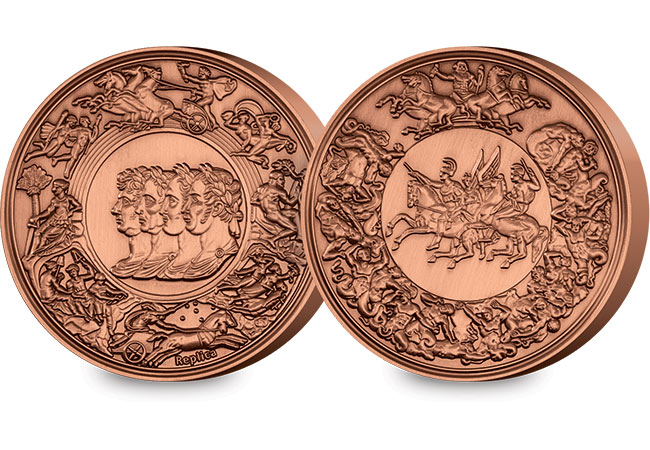
Using the latest minting technology, a small batch of just 495 replica medals have been made for the anniversary year of The Battle of Waterloo. We still have some available if you’re interested, click here for details.


